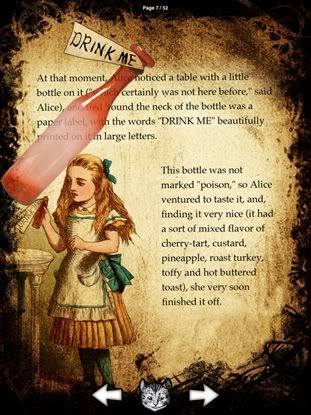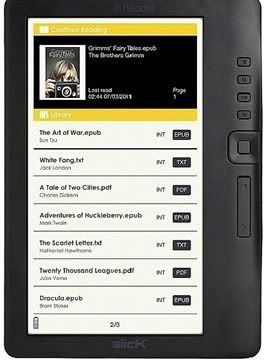 My sister the retired schoolteacher came to e-books only late in life, but you’d never know it from her enthusiasm for her iPad as a reading tool. Dorothy can blow up the type, for example. She actually reads faster than before. In fact, she hopes to use e-books to help spur her grandchildren to read.
My sister the retired schoolteacher came to e-books only late in life, but you’d never know it from her enthusiasm for her iPad as a reading tool. Dorothy can blow up the type, for example. She actually reads faster than before. In fact, she hopes to use e-books to help spur her grandchildren to read.
How can Dorothy best succeed at this? And what about parents and grandparents in low-income households without paper books and without her educational background; could similar technology work for them?
Suppose Alice for the iPad and other good e-reading programs not only were accessible to the disadvantaged in Anacostia and Appalachia but also were used properly, so that toddlers and other younger children would absorb words and ideas, not just get caught up in electronic bells and whistles. At $8.99 the full Alice app is probably overpriced for an e-book like this. But in a review in the iTunes store, one mother gushed about the free “Lite” version: “When I told my daughter that she has to read to me tonight, her first question was ‘How many pages?’, hoping it had to be just a few. Then I showed her this book. She started reading, giggling as she encountered moving objects. She didn’t want to stop reading! I actually had to tell her to stop and go to bed. So I guess it’s five stars.” A public national digital library system should serve people of all income levels and all ages, centenarians included, but books for young, disadvantaged children are one area where it could make a special difference, and better-off families would benefit along the way.
Tablet computers for toddlers and families: LibraryCity.org’s past posts on the proposal
Related: The connection between access to books and student achievement. For a more general vision of a national digital library system: LibraryCity’s Chronicle of Higher Education article. |
According to Reading Is Fundamental, “nearly two-thirds of low-income families in the U.S. own no books.” Besides, there’s also another issue: How closely will the books match the needs and interests of children and of parents–and grandparents–who ideally can find their own favorite titles and better serve as role models? Right now public libraries are typically buying more e-books than before for all age groups, but are up against tough restrictions from some major publishers fixated on shoring up their shrinking paper sides. Whether by carrot or stick–I’d hope the former, by way of a library-related mechanisms to pay content creators fairly–policymakers need to change this in the public interest.
Simply put, literacy efforts in the U.S. might take a major step forward if teachers, librarians, RIF’s 400,0000+ volunteers, and other literacy workers could use library e-books to augment paper books in disadvantaged households now without appropriate hardware and connectivity. Besides, aren’t e-books better than none at all? I’ve already outlined the general concept and told how to cost-effectively experiment with tablets for early childhood education and use them for other purposes such as multimedia information on topics such as childcare, health, and nutrition. I agree with Rebecca Greenfield’s essay in TheAtlantic.com: matters like nutrition are far more important than the “app gap” mentioned in the New York Times–hence, my interest in the additional potential of the tablets to educate parents in areas such as health and even help remind them of pediatric appointments (as well as faithfully follow doctors’ advice).
Ahead, based on my thoughts as an ex-child and a former poverty beat reporter who wrote on Head Start among other related topics, are my further ideas as a non-educator. They are not necessarily those of RIF or of the Digital Public Library of America project, which this independent Web site has been following and hoping to nudge toward more interest in literacy programs and other benefits for the non-elite.
Recommendation #1: Aim for a mix of electronic and paper books
“For Their Children,” blared a headline in the New York Times, “Many E-Book Fans Insist on Paper.” Thanks, NYT. You actually made me nostalgic for the days when the press was pooh-poohing the chances of e-books in general succeeding. Rick Broida, a CNET blogger with more than 20 years as a tech writer, was far more sanguine in 5 amazing iPad e-books for Kids (Alice among them). And so were his commenters. Who’s right?
No, we needn’t choose between electronic and paper books. RIF could continue to distribute paper books as gateway drugs, so to speak–ways to whet the interests of children and parents. Here’s to oddly shaped p-books, those with pop-ups and other fun! The children could use e-books, too, however, especially to explore their special interests in situations when paper books were not available. One of my early utterances was, “Man in sky.” Imagine how I’d have gone to town with a vast collection of picture books with space-related themes. Young children should learn to follow their passions, in line with the logic behind the 10,000 hour rule; becoming an expert in anything is to a great extent simply a matter of giving it enough time. Perhaps in the future E by itself will suffice without paper alternatives for toddlers and slightly older siblings. Meanwhile we can experiment, with appropriate experts tracking the results in quantified and nonquantified ways, before reaching final conclusions.
What is indisputable is the ultimate ability of e-books to increase reading choices for children and parents, thanks to the economies of production and distribution. Libraries could experiment with with powerful iPad-style hardware in anticipation of the time when, just as with adding machines, costs will be a fraction of what they are now.
Recommendation #2: Investigate the efficacy not just of different kinds of e-book content but also of ways to use it
 Yes, experts should continue to assess the success of different kinds of e-books in teaching preschool children and others–for example, multimedia vs. the old-fashioned kind. I also wonder about scanned e-books vs. original digital offerings specifically meant for read-aloud sessions with children. I love the work that the International Children’s Digital Library is doing. But with many scanned books, parents could have trouble showing some of the text and pictures to the children at once; the related images may not be on the same page, making it harder for the children to associate them with specific words. Also, the ICDL books, at least typically, are missing such capabilities as the ability to hear an individual word pronounced as it’s highlighted. The generally well-thought-out Alice program, though from a commercial source, lacks any kind of read-aloud feature and perhaps not enough animation features for some parents’ tastes. How much to include, especially for households where the parents may not use the best pronunciation? Consider all the pros and cons. Will the showy features enrich the children or simply cause them to be bored with less flashy print books?
Yes, experts should continue to assess the success of different kinds of e-books in teaching preschool children and others–for example, multimedia vs. the old-fashioned kind. I also wonder about scanned e-books vs. original digital offerings specifically meant for read-aloud sessions with children. I love the work that the International Children’s Digital Library is doing. But with many scanned books, parents could have trouble showing some of the text and pictures to the children at once; the related images may not be on the same page, making it harder for the children to associate them with specific words. Also, the ICDL books, at least typically, are missing such capabilities as the ability to hear an individual word pronounced as it’s highlighted. The generally well-thought-out Alice program, though from a commercial source, lacks any kind of read-aloud feature and perhaps not enough animation features for some parents’ tastes. How much to include, especially for households where the parents may not use the best pronunciation? Consider all the pros and cons. Will the showy features enrich the children or simply cause them to be bored with less flashy print books?
In a similar vein, I wonder about commercially created e-books whose mechanical voices parents cannot turn off, so the mothers and fathers themselves can read aloud to their offspring. Better to allow choice? I found that Christmas Eve, a free iPad program (above screenshot) from a French company named So Ouat, offers a healthy mix of good software ergonomics and user options, at least in my opinion. Agree? If so, is it time for schools and libraries to encourage the creation of more software like this, not just the scanning of existing books? An opportunity for corporations and nonprofits alike, including ICDL itself? It isn’t as if we currently lack e-reading apps for young children. The main goal, rather, should be quality rather than mere quantity, even though it would help to come up with content serving a wide variety of interests. Educational values should prevail here over commercial priorities, one argument for a well-planned, well-run national digital library system that does not neglect young families, even as it serves other demographic groups.
The effectiveness of the actual books for children is just one issue. As part of preschool programs, children may learn how to hold and otherwise use a book; e-tech is more complicated for them and their parents alike. One question is the extent to which to associate multipurpose iPad-style devices with reading, as opposed to other activities. A Boston pediatrician, Gwenn Schurgin O’Keeffee, reportedly has even said that children under two should not fiddle around with iPads except when the devices are displaying books. I myself can envision parents using the multimedia for themselves to master topics such as childcare and health-related ones. But that is different from just plopping an unattended toddler down in front of the iPad.
More issues arise. Should parents at first focus on an e-book’s overall plotline or the main information, as opposed to getting the child caught up in electronic extras? How to keep his or her mind on substance as opposed to the medium? Also, is it possible that just turning a child loose on a colorful, interactive e-book could stifle imagination in come cases? And how about the risks of relying too much on e-books as babysitters for young children, rather than as read-aloud fodder for parents? One of Broida’s commenters, self-identified as a speech therapist, warns that excessive use of DVDs and other baby-sitters may stymie toddlers’ language development. At the same time the therapist is a booster of e-books, if properly used, for young children. He or she notes the enhanced experience available through such wrinkles as “the wonderful surprises behind the objects” that a child can tap. “This, and dozens of other benefits, have allowed me to facilitate development through technology. The key is the adult–the risk that adults will use technology to replace direct interaction with children.”
The therapist is almost surely right in saying that such a problem is “the norm.” This is where a focused initiative–with librarians, teachers, literacy volunteers and other around to keep the parents on track, through in-person demonstrations of reading techniques and through other encouragement–could go a long way. Here’s to child-parent bonding! You might think of it as the ultimate social medium and the ultimate educational one as well. The technology itself will just do harm if misused. Parent and children can read alone, and perhaps some machine-automated reading is fine; but maybe, just like a dead man’s switch to verify that a locomotive engineer is on the job, software should be include ways of ascertaining that a mother is actually reading to her child, as opposed to simply letting the tech serve as a babysitter.
Recommendation #3: Strive for appropriate hardware, software, and connectivity
 As for the optimal hardware for experiments with mother-child reading, researchers should try not to stint. That could mean large color screens and perhaps the use of actual iPads, given the wide variety of easy-to-use applications for them. The better Android alternatives should be tried as well. As noted earlier, the equipment should either be rugged through the original design or perhaps should be used with protection against drops and spittle.
As for the optimal hardware for experiments with mother-child reading, researchers should try not to stint. That could mean large color screens and perhaps the use of actual iPads, given the wide variety of easy-to-use applications for them. The better Android alternatives should be tried as well. As noted earlier, the equipment should either be rugged through the original design or perhaps should be used with protection against drops and spittle.
Not all reading hardware needs will be the same even within families. I like the idea of young children having their own tablets, as long as parents supervise them closely to make sure they’re not simply used for games. Perhaps smaller screens would work out for many children. E-book-capable tablets go for less than $100: in fact, as I write this, the Slick ER-701 e-reader with a seven-inch color screen is on sale for as little as $45 from Dollar General, or $15 less than the usual $60. Although it lacks built-in WiFi to make it easier to obtain e-books, I suspect that feature will show up in time in similar econo-units. Meanwhile librarians could experiment with bargain machines already stocked with popular e-books of interest to young families. I have a Slick on order to see if, when preloaded, it’s easy enough for even computerphobes to use. Some techies like it even if it’s just for e-reading, music, and certain multimedia formulas and cannot run the thousands of programs that iPads and Android tablets can. Imagine the DPLA and related organizations coming up with specs and programs that vendors like Slick could use to make even the most computer-shy person comfortable with a national digital library. They could even offer prototypical firmware configurations for Android tablets and other machines more powerful than the Slick to assure Kindle-seamless integration with national and local library systems.
Software? Ideally participants in the initiative could work with the software development community and hardware vendors to bake in monitoring mechanisms, so the equipment wasn’t simply used for games. And keep the reading programs simple to use, with a chance for parents and children to upgrade instantly to more complicated ones. Focus on the needs of ordinary families, as opposed to those with budding young hackers, who can always be helped separately; traditional literacy, not the advanced computer kind, should be the main show here, even though the two can be intertwined.
And don’t forget yet another ingredient–easy-to-use connectivity, whether through cable, DSL, or wireless. Good tech support would help as well. Tech-hip librarians could show how to install and use applications. While some disadvantaged young people may be geeks at heart, the majority are not.
Finally, in terms of use of full hardware and software, stands and keyboards might help so that parents and old enough children could also use the tablets for writing if they lacked desktops. It would be one way to send-in questions for librarians, for example, or write as students in literacy programs or annotate books or use library-oriented social media. And for voice-based queries? Why not use microphones, with Skype-style programs, to make it easy for parents to call librarians and others when that’s the most efficient approach?
Needed more than ever–and not just for the disadvantaged
This is hardly an all-inclusive description of the proposed experimental initiative, but ideally can help researchers get started. Certainly the need for well-funded investigations, beyond current and past ones, is there. Twenty-nine percent of tablet owners let their children use the devices, and among mothers, the figure rises to 65 percent, according to a recent Bloomberg report, headlined “IPad-crazed Toddlers Spur Holiday Sales.” Apple has shipped around 40 million tablets globally since 2009, with perhaps half that number expected to be sold during this holiday quarter. And sales of Android products are booming, especially with Amazon’s introduction of the Kindle Fire, tweaked but still an Android product under the hood.
In determining how the tablets could best help disadvantaged families, a well-done investigative initiative might also help the lucky ones already owning the iPad-style devices (just a fraction of our population). Children in so many ways are simply children, disadvantaged or not.
As a teacher, grandmother, and citizen, my sister the e-book fan would almost surely agree.
Of possible interest: The Digital Media Diet blog, with such entries as Holiday Reading: Our Top 25+ Recommendations for Children’s iPad Picture Book Apps, iPads in Education: How You and your iPad can volunteer together in your child’s classroom, Recommended iPad Book Apps for Older & Struggling Readers Ages 10 Up, and How Will iPad picture books affect young readers’ literacy? The blog’s editor-reviewer, Carisa Kluver, is a mother holding an undergraduate degree in anthropology and a masters in social work and has worked in education. Also see literacy expert Pam Allyn‘s reviews of reading-related apps for children.
A work in progress: Got anything to add or dispute? Speak up in the comments area or email me at [email protected]. In some cases I may be changing the above essay in response.
Republished with permission of the author – via his site LibraryCity, On the Digital Public Library of America, the digital divide, and related topics
